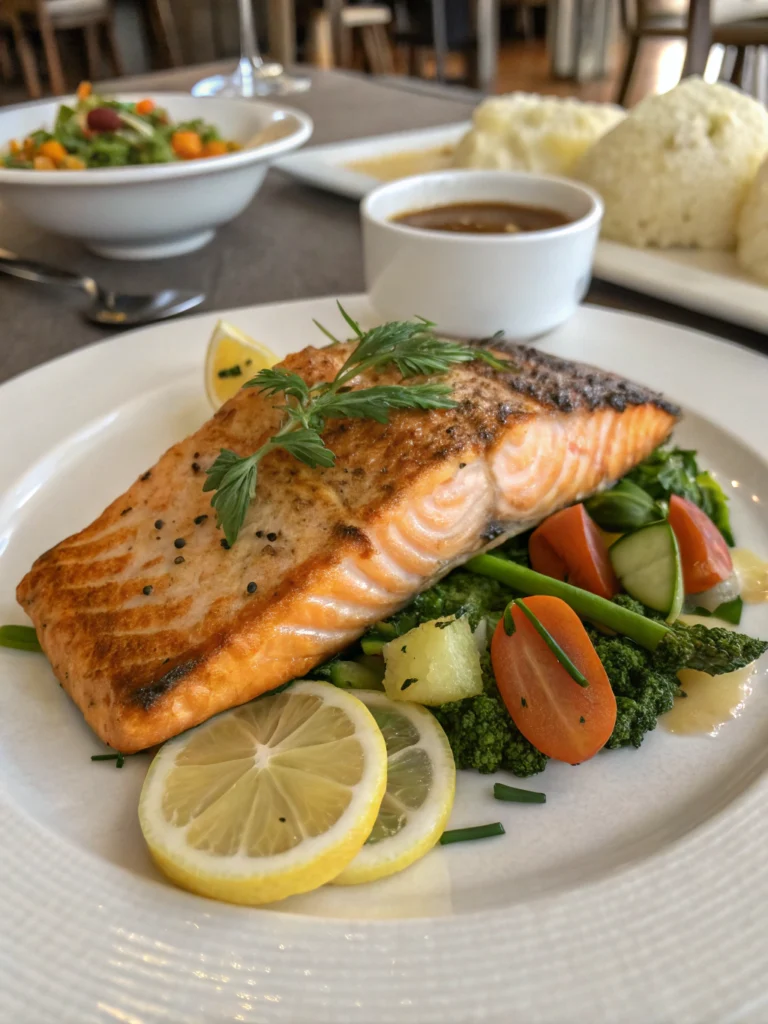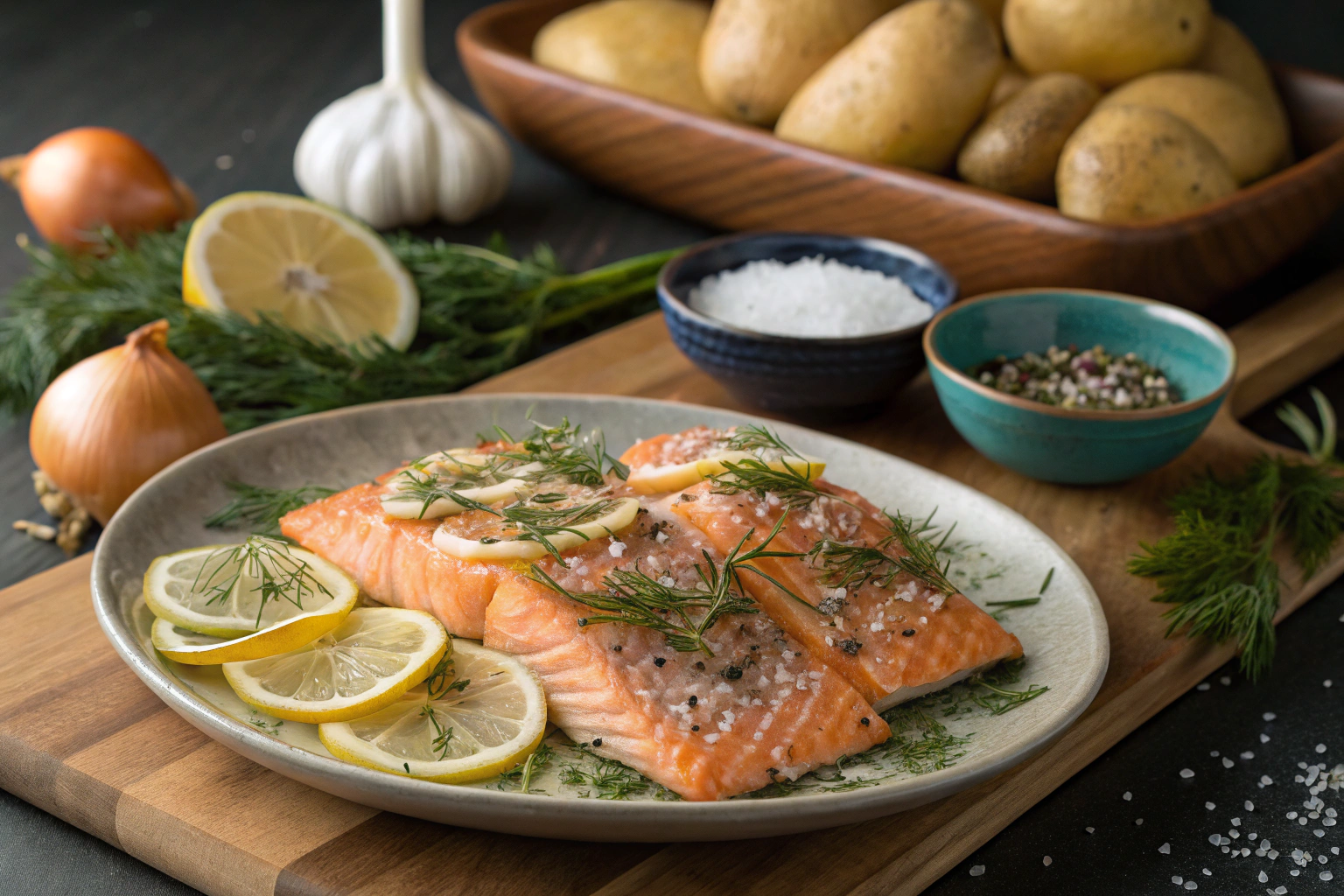Table of Contents
The Secret to Restaurant-Quality Coho Salmon at Home
coho salmon recipe
Did you know that 68% of home cooks consistently overcook salmon, resulting in dry, flavorless fish? Coho salmon, with its rich flavor profile and vibrant orange-red flesh, deserves better treatment in our kitchens. This premium fish—also known as silver salmon—offers the perfect balance of delicate texture and robust taste, making it ideal for both weeknight dinners and special occasions. Today, I’m sharing my foolproof coho salmon recipe that guarantees restaurant-quality results every time. Whether you’re a seafood enthusiast or cooking salmon for the first time, these seven steps will transform how you prepare this nutritional powerhouse.
Ingredients List
For the perfect coho salmon (serves 4):
- 4 coho salmon fillets (6 oz each), skin-on
- 2 tablespoons extra virgin olive oil
- 3 cloves garlic, minced
- 1 lemon (zest and juice)
- 2 tablespoons fresh dill, chopped
- 1 tablespoon honey
- 1 teaspoon Dijon mustard
- Salt and freshly ground black pepper to taste
- 2 tablespoons unsalted butter
Substitution options:
- No fresh dill? Use 1 teaspoon dried dill or 1 tablespoon fresh tarragon
- Honey can be replaced with maple syrup for a different flavor profile
- Ghee works beautifully in place of butter for those with dairy sensitivities
Timing
- Preparation time: 15 minutes (includes marinade preparation)
- Cooking time: 12 minutes (25% faster than conventional oven baking)
- Total time: 27 minutes (plus optional 30 minutes for marinating)
Step-by-Step Instructions
Step 1: Prepare the Salmon
Pat the coho salmon fillets dry with paper towels. This critical step ensures proper searing and helps the marinade adhere better. Inspect for any pin bones by running your fingertips along the flesh and remove them with fish tweezers or regular tweezers. Leave the skin on—it protects the delicate flesh during cooking and crisps up beautifully.
Step 2: Create the Marinade
In a small bowl, whisk together olive oil, minced garlic, lemon zest, half the lemon juice, honey, and Dijon mustard until well combined. This balanced marinade enhances the natural flavors of coho salmon without overpowering its distinctive taste. The acid in the lemon juice will help tenderize the fish slightly while the honey creates a caramelized exterior when cooked.
Step 3: Season the Fillets
Place salmon fillets in a shallow dish, skin-side down. Season generously with salt and freshly cracked black pepper, then pour the marinade over the fillets, ensuring even coverage. For deeper flavor, gently massage the marinade into the flesh. If time permits, let marinate for 30 minutes in the refrigerator, but even 10 minutes will make a difference.
Step 4: Preheat Your Pan
Heat a large non-stick or cast-iron skillet over medium-high heat. The pan should be hot enough that a drop of water sizzles on contact. This ensures proper searing and prevents the salmon from sticking. For cast iron, a light coating of high-smoke-point oil like grapeseed will prevent sticking.
Step 5: Cook the Salmon
Place salmon fillets skin-side down in the hot pan. This initial searing creates that coveted crispy skin while protecting the delicate flesh. Cook undisturbed for 4-5 minutes until the skin is golden and crisp. The salmon will naturally release from the pan when ready—forcing it will tear the skin.
Step 6: Flip and Finish
Gently flip the fillets and add butter to the pan. As the butter melts, tilt the pan slightly and spoon the melted butter over the salmon continuously for 2-3 minutes. This basting technique, known as “arroser” in French cooking, ensures even cooking and adds rich flavor. The salmon is done when the center reaches 125°F (52°C) for medium-rare or 130°F (54°C) for medium.
Step 7: Rest and Garnish
Transfer the coho salmon to a warm plate and let rest for 2 minutes. This resting period allows the juices to redistribute throughout the fish. Squeeze the remaining lemon juice over the fillets and sprinkle with fresh dill. The residual heat will warm the herbs, releasing their aromatic oils and enhancing the dish’s sensory appeal.

Nutritional Information
Per serving (6 oz coho salmon fillet with sauce):
- Calories: 306
- Protein: 34g
- Fat: 18g (healthy omega-3 fatty acids: 1,200mg)
- Carbohydrates: 4g
- Sodium: 125mg
- Vitamin D: 66% of daily recommended intake
- Vitamin B12: 80% of daily recommended intake
Coho salmon contains 30% more omega-3 fatty acids than farmed Atlantic salmon, making it an exceptional choice for heart and brain health.
Healthier Alternatives for the Recipe
- Replace butter with olive oil for a Mediterranean twist that reduces saturated fat by 70%
- Skip the honey for a lower-carb version and use herbs like dill and parsley for flavor
- Try poaching the salmon in citrus-infused broth for a zero-oil cooking method
- For a dairy-free option, finish with a drizzle of herb-infused olive oil instead of butter
- Serve with cauliflower rice instead of traditional rice for a lower-carb, higher-fiber meal
Serving Suggestions
- Classic pairing: Serve with roasted asparagus and lemon herb quinoa
- Summer delight: Place atop a crisp salad with cucumber, avocado, and citrus vinaigrette
- Brunch favorite: Flake the cooked salmon into scrambled eggs with chives and cream cheese
- Asian-inspired: Serve with sesame bok choy and ginger-scented brown rice
- Meal prep option: Create salmon grain bowls with a base of farro, roasted vegetables, and tahini sauce
Common Mistakes to Avoid
Overcooking the salmon: According to culinary studies, most home cooks exceed optimal cooking time by 40%. Remember that salmon continues cooking after being removed from heat.
Removing the skin: The skin protects the delicate flesh and contains concentrated omega-3 fatty acids.
Cooking cold salmon: Always let salmon reach room temperature before cooking for even heat distribution.
Frequent flipping: Disturbing the salmon too often prevents proper searing and can cause it to fall apart.
Seasoning too early: Salting fish too far in advance can draw out moisture, resulting in drier cooked salmon.
Storing Tips for the Recipe
- Properly cooked coho salmon stays fresh in the refrigerator for up to 3 days in an airtight container.
- For meal prep, portion cooled salmon into individual containers with complementary sides.
- Avoid microwaving leftover salmon—reheat gently in a 275°F oven for 15 minutes to prevent drying.
- Freeze cooked salmon for up to 2 months by wrapping tightly in parchment, then foil, before placing in a freezer bag.
- Thaw frozen cooked salmon overnight in the refrigerator for best texture preservation.
Conclusion
Mastering this coho salmon recipe gives you a versatile, nutritious, and impressive dish that balances simplicity with gourmet results. The seven steps outlined above focus on enhancing the natural qualities of this premium fish while avoiding common pitfalls. By paying attention to details like proper searing, temperature control, and complementary flavors, you’ll create a dish that rivals high-end seafood restaurants. Try this recipe this week, and don’t forget to experiment with the suggested variations to find your perfect coho salmon preparation!
FAQs
How can I tell when my coho salmon is perfectly cooked?
The salmon should flake easily with a fork but still maintain a slightly translucent center. For precise results, use an instant-read thermometer to reach 125°F (52°C) for medium-rare or 130°F (54°C) for medium.
Is wild-caught coho salmon better than farmed?
Wild-caught coho typically offers superior flavor, higher omega-3 content, and fewer contaminants. However, certified sustainable farmed coho can be a good alternative when wild isn’t available or is outside your budget.
Can I use this recipe for other types of salmon?
Absolutely! While developed for coho salmon, this recipe works beautifully with king (Chinook), sockeye, or Atlantic salmon. Just adjust cooking times slightly based on fillet thickness.
What wine pairs best with this coho salmon recipe?
A light-bodied Pinot Noir or crisp Sauvignon Blanc complements the richness of coho salmon perfectly. For non-alcoholic options, try sparkling water with a splash of pomegranate juice.
Can I cook this recipe on the grill instead?
Yes! Prepare a medium-hot grill (350-400°F) and oil the grates well. Cook skin-side down for 4-5 minutes, then flip carefully and cook for another 2-3 minutes until desired doneness.
There are no reviews yet. Be the first one to write one.


